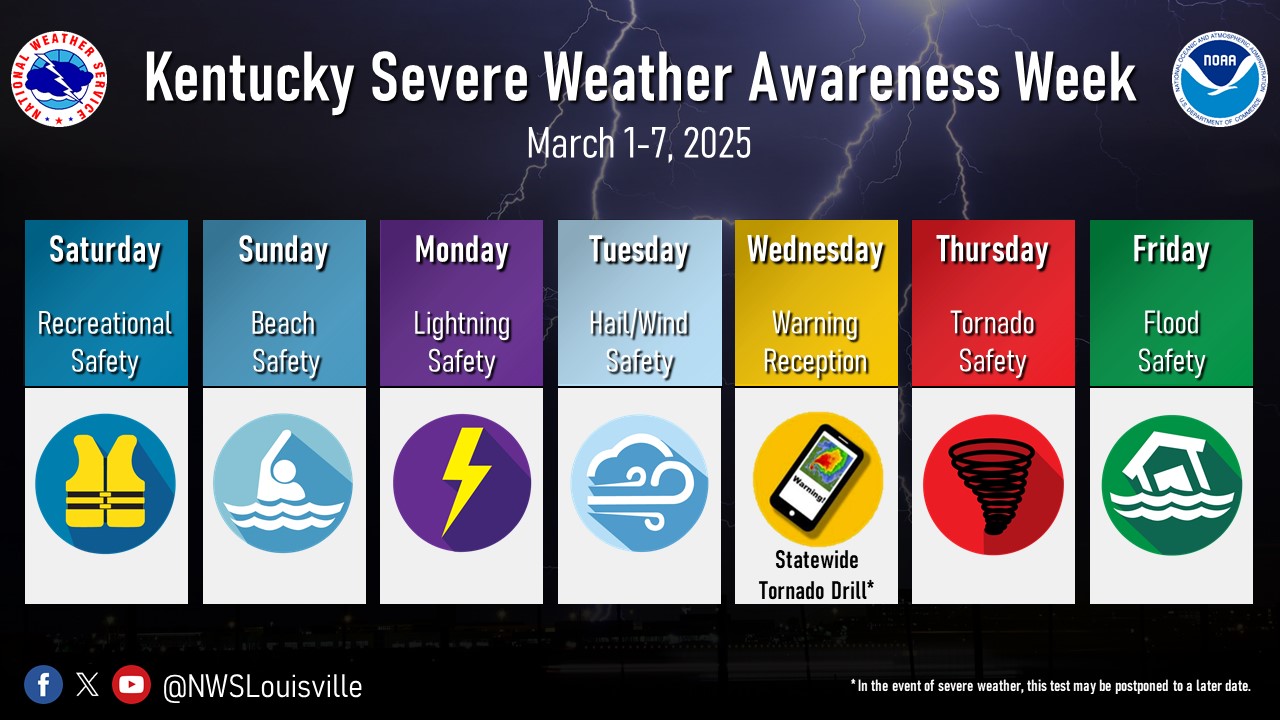Understanding Flood Risks: A Guide For Severe Weather Awareness Week

Table of Contents
Identifying Your Flood Risk
Determining your flood risk is the foundation of effective flood preparedness. This involves understanding your location's flood history and susceptibility to various types of flooding. Utilizing readily available resources and conducting a thorough site assessment are key components of this process.
-
Check FEMA Flood Maps: The Federal Emergency Management Agency (FEMA) provides detailed flood maps (fema.gov) that delineate high-risk flood zones. These maps show areas with a statistically significant chance of flooding. Knowing if your property lies within a high-risk zone is crucial for determining your insurance needs and preparedness strategies. Look for your address and identify the designated flood risk zone.
-
Assess Your Property's Elevation: Your property's elevation relative to nearby rivers, streams, and coastlines significantly impacts your flood risk. Higher elevation generally reduces the risk of flooding, but even slightly elevated areas can still be vulnerable during extreme weather events. Consider using topographic maps or contacting local surveying services to determine your precise elevation.
-
Research Historical Flood Data: Investigate your area's history of flooding. Local news archives, government records (often available at your city or county's website), and historical society resources can provide valuable insight into past flood events, their severity, and affected areas. This information helps you gauge the potential for future floods.
-
Observe the Surrounding Landscape: Pay close attention to the geography surrounding your property. Low-lying areas, poor drainage systems, proximity to waterways, and the presence of culverts or storm drains can all contribute to your flood risk. Identify potential pathways for floodwaters to reach your property.
Understanding Different Types of Flooding
Not all floods are created equal. Different types of flooding pose unique challenges and necessitate varied preparedness strategies. Recognizing these distinctions is essential for effective flood mitigation.
-
River Flooding: This is the most common type of flooding, typically caused by prolonged rainfall or rapid snowmelt that overwhelms rivers and streams. River flooding often provides more warning time than flash flooding.
-
Flash Flooding: Characterized by a rapid and unexpected rise in water levels, flash floods often result from intense, localized rainfall. These events provide little to no warning, making immediate response crucial. Flash flood risk is higher in areas with steep slopes, limited drainage, and dry riverbeds.
-
Coastal Flooding: Caused by storm surges, high tides, and powerful waves associated with hurricanes and other severe weather events. Coastal flooding poses a significant threat to communities along coastlines and presents unique challenges.
-
Pluvial Flooding: This occurs when intense rainfall exceeds the capacity of drainage systems, leading to street flooding and ponding of water. Urban areas with inadequate drainage infrastructure are particularly susceptible to pluvial flooding.
-
Sewer Flooding: Overwhelmed sewer systems can back up into homes and businesses, causing significant damage and health hazards. Sewer flooding is often associated with heavy rainfall and inadequate drainage capacity.
Preparing for a Flood
Proactive preparation is paramount in mitigating flood damage and ensuring your safety. Developing a comprehensive flood preparedness plan is a vital step in protecting your family and property.
-
Create a Family Emergency Plan: This plan should detail evacuation routes, designated meeting points outside the flood zone, and communication strategies. Include contact information for family members and emergency services. Practice your evacuation plan regularly.
-
Assemble a Flood Emergency Kit: Your kit should include essential supplies such as potable water (at least one gallon per person per day), non-perishable food, medications, first-aid supplies, flashlights, batteries, a portable radio, and important documents (stored in waterproof containers).
-
Consider Flood Insurance: Even if you're not in a high-risk flood zone, consider purchasing flood insurance. Standard homeowner's insurance policies typically don't cover flood damage. Flood insurance provides vital financial protection in case of a flood event.
-
Implement Flood Proofing Measures: Elevating electrical outlets and appliances, installing waterproof seals around doors and windows, and using sump pumps can help protect your property from flood damage. Consider installing backflow valves to prevent sewer backups.
-
Learn to Safely Turn Off Utilities: Know how to turn off the electricity, gas, and water to your home in case of a flood. This is a crucial safety precaution to prevent further damage and potential hazards.
Responding to a Flood
Knowing how to respond during and after a flood is critical for ensuring your safety and minimizing damage. Timely action and adherence to safety guidelines are paramount.
-
Monitor Weather Forecasts and Warnings: Pay close attention to weather forecasts and heed flood warnings and watches issued by local authorities. Be prepared to act quickly if a flood threat emerges.
-
Evacuate Immediately if Ordered: Comply with evacuation orders issued by emergency management officials. Do not delay; your safety is paramount.
-
Never Drive Through Flooded Areas: Flooded roads can be extremely dangerous. The depth of the water is often difficult to judge, and even shallow water can sweep a vehicle away. Turn around, don't drown.
-
Post-Flood Cleanup: After the floodwaters recede, prioritize safety. Be aware of potential hazards such as downed power lines, contaminated water, and structural damage. Contact your insurance company promptly to begin the claims process.
-
Document Flood Damage: Take photos and videos of the damage to your property to support your insurance claim. Keep detailed records of expenses related to the cleanup and repairs.
Conclusion
Understanding flood risks is paramount for protecting your family, property, and community. By proactively identifying potential hazards, preparing for flooding, and responding effectively during and after a flood event, you can significantly minimize the devastating impact of this natural disaster. This Severe Weather Awareness Week, make a commitment to enhancing your flood preparedness. Learn more about assessing your flood risks and developing a comprehensive flood safety plan today. Don't wait – understand your flood risk and protect your family!

Featured Posts
-
 French Open 2024 Alex Ealas Path To Success
May 26, 2025
French Open 2024 Alex Ealas Path To Success
May 26, 2025 -
 Uefa Real Madrid In Doert Yildizina Yoenelik Sorusturmayi Acikladi
May 26, 2025
Uefa Real Madrid In Doert Yildizina Yoenelik Sorusturmayi Acikladi
May 26, 2025 -
 2005 Romance Films Unexpected Box Office Boom After Two Decades
May 26, 2025
2005 Romance Films Unexpected Box Office Boom After Two Decades
May 26, 2025 -
 Fcm Legende Lars Fuchs Dankbarkeit Fuer Den Bundesliga Traum
May 26, 2025
Fcm Legende Lars Fuchs Dankbarkeit Fuer Den Bundesliga Traum
May 26, 2025 -
 Reclaiming The Hunger Games A Look At Ohnotheydidnts Live Journal Archive
May 26, 2025
Reclaiming The Hunger Games A Look At Ohnotheydidnts Live Journal Archive
May 26, 2025
Latest Posts
-
 Ice Cube To Write And Star In New Last Friday Movie
May 27, 2025
Ice Cube To Write And Star In New Last Friday Movie
May 27, 2025 -
 Official Ice Cube Returns For A New Last Friday Film
May 27, 2025
Official Ice Cube Returns For A New Last Friday Film
May 27, 2025 -
 Ice Cubes Last Friday Movie A New Chapter In The Franchise
May 27, 2025
Ice Cubes Last Friday Movie A New Chapter In The Franchise
May 27, 2025 -
 Last Friday Sequel In The Works With Ice Cube
May 27, 2025
Last Friday Sequel In The Works With Ice Cube
May 27, 2025 -
 Last Friday Franchise Continues Ice Cube Officially On Board
May 27, 2025
Last Friday Franchise Continues Ice Cube Officially On Board
May 27, 2025
